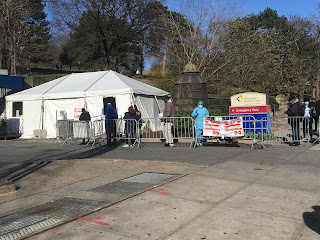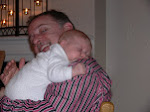At my father’s 80th birthday party his four children each prepared a little speech in which we discussed, among other things, his influence on us. My theme: What if the war comes?
Born in 1925 into a family of (eventually) seven children; being raised in the Depression on his father’s bank-teller salary; spending years eating Miracle Whip-on-Wonder sandwiches and getting big Christmas treats of a single orange; handing over every penny of his magazine route to his mother for the household economy; having grown several inches in both middle school (when he lived in a seminary before declining the priesthood) and his Army years (which ended in 1945 when he was wounded in France) because he was finally consuming a sufficient number of calories: all contributed to my father’s instinct toward parsimony.
He could master the instinct. He bought himself (and his fortunate children) San Francisco 49ers season tickets from the late ‘40s into the ‘90s. In an apparent moment of midlife crisis he shocked us by trading in the Volkswagen Beetle for a Datsun 260-Z sports car.
But as a rule Dad never parted with a nickel when he could part with a penny. He despised waste: we cleaned our plates, never used two paper towels when one would do, wrenched every last squeeze from a toothpaste tube. Dining out was a rarity. Our mother, who also worked, spent weeks one year to convince him to let the family take, rather than our usual car-camping vacation, a trip to Europe (where our bible was “Europe on $5 and $10 a day”). Woe to the child leaving a coat or dress heaped on a floor, at whom he’d snap, “You can stop using hangers when you’re buying your own clothes.”
Despite growing up comparatively fat and middle class and facing nothing like his life of pervasive social peril, his children, to one degree or other, inherited this sensibility, for which my shorthand became: What if the war comes? Why do I keep spices for more than a decade? Why keep a change jar? Why dig the toothpaste tube from the trash for a final three uses? Why cringe when The Girlfriend pulls out a skein of dental floss 6 inches longer than necessary? Why keep a plastic fruit-and-vegetable bag stuffed with other plastic fruit-and-vegetable bags? Well: what if the war comes?
And now, in the spring of 2020, with the advent of the Covid-19 pandemic, living in the middle of the nation’s viral epicenter of New York City, at last: The war has come!
Let me not exaggerate. My market across the street remains open and, if not one day then the next, reasonably well stocked. I live in a lovely apartment, with enough to buy what I need and to eat quite well. The Kid has everything she could want, including a college fund. I try to remember to be grateful for the bounty that pours into my life.
But having to plot every trip outside; having to plan meals a week in advance to avoid grocery store visits; facing real shortages of items I could use (thermometers, say); unable to buy things even through the plenitude of our online suppliers — all of this has thrust me into a war-time mentality.
The Girlfriend shares some of this. Her father, a Holocaust survivor, takes for granted no social abundance. I thought I was a reasonable Food-Waste Cop, but she’ll eat things from the fridge I’d have thrown out last week. If she sees me scraping a quarter-helping of food into the trash rather than a Tupperware, she snaps in a tone my father would have admired.
My best friend upstate says he’s absorbed the mindset. He’s rinsing out and reusing freezer bags. He’s mixing his own milk, which he says isn’t bad if you combine powdered with evaporated. He’s stopped using toilet paper, having purchased a few years ago an attachable bidet, which he swears by.
Ah, toilet paper: the nation’s most desired item, at least according to my social media feeds.
I wasn’t worried when physical isolation started, still having two of four large rolls bought a week or so prior. But The Girlfriend and I moved through them much faster than I’d anticipated. On Sunday, as we broke out my single-ply, use-only-under-extreme-conditions emergency roll, she id’d the cause: “I’ve been drinking so much tea, water, juice, I’m peeing like 20 times a day.”
I put TP on my list when my sister and her boyfriend shopped for me on Sunday, but, as it had been for two weeks, our market was out. The single-ply roll would last for a few days; after that, I surmise, we’ll be using tissues.
We awake Monday morning early. The Girlfriend feels better than she has in a week. She’s ready to go for a walk, she says, and, as I’m feeling pretty good, too, we head out to see if one of our local bagel shops is open. Twice The Girlfriend has to tell me to slow down; she’s better but hasn’t been out of the apartment in four days, feels fragile. As we pass the market I see a couple of its staff unloading trucks. A thought occurs.
“Have any toilet paper?”
“One box,” the staffer says, wiping his brow with a gloved wrist. “It’s in Aisle Two.”
I tell The Girlfriend to wait. As I run in she says, “Can you get soda water?”
The sister/boyfriend shopping expedition was a godsend, but they bought four bottles of watermelon-flavored soda water, which proves to be unpotable. (Not that that will stop The Girlfriend from drinking it if she must.)
I dash in, see only two other customers. I head to Aisle Two, whose shelves are empty of not only toilet paper but paper towels, tissues, napkins — any pulpable item you can name, save a few stacks of plates. Then I see it, at the end the aisle at the bottom of a stack of boxes: a box stamped with a brand I recognize. I unstack the pile, find the box open, one of its three containers of 12 rolls already removed. I take the second one, grab four lemon-flavored soda waters, head for the cashier. No line. My bill is almost $15. TP is expensive. I walk out. No Girlfriend.
Did she go back to the apartment? I run to the courtyard — no sign of her. I run around to the front, go upstairs — no sign. I deposit my TP and soda, run to the 12th-floor windows — no sign. It reminds me of The Kid’s younger years, in a couple of horrible moments when I lost track of her. Not that The Girlfriend can’t take care of herself, of course. But she’s so weak. I check: her phone sits on the counter. What if she falls? These aren’t normal days. I run downstairs, start running to the bagel shop. A couple of blocks away, here she comes, moving slower than my 89-year-old mother. The bagel shop is closed, she says.
“Why did you leave?”
“You asked me to! You said, ‘Walk.’ Like you were going to catch up with me.”
“I didn’t say ‘Walk.’ I said ‘Wait!’”
“Well, I thought it was weird. But I thought you wanted me to prove I could do it. Like a dose of tough love.”
“I like tough love more than most, but I wouldn't do that to you while you're sick!”
“I'm not that sick.”
We go upstairs, slowly. In the bathroom I break open the package; the room immediately fills with a horrible chemical-floral scent.
“What is that?”
“I think it’s the toilet paper.”
“My God! Who wants to use that? That’s just awful.”
I’ve already ripped open the package to stack the rolls in my utility closet. I find a garbage bag to enclose the scent.
Under normal conditions I’d throw it away, but now I dismiss the thought. After all, the war has come.
(New York state numbers as of Monday: 66,497 diagnosed with Covid-19, up 12 percent; 1,218 dead, up 26 percent. Overall U.S. deaths: 2,968.)



